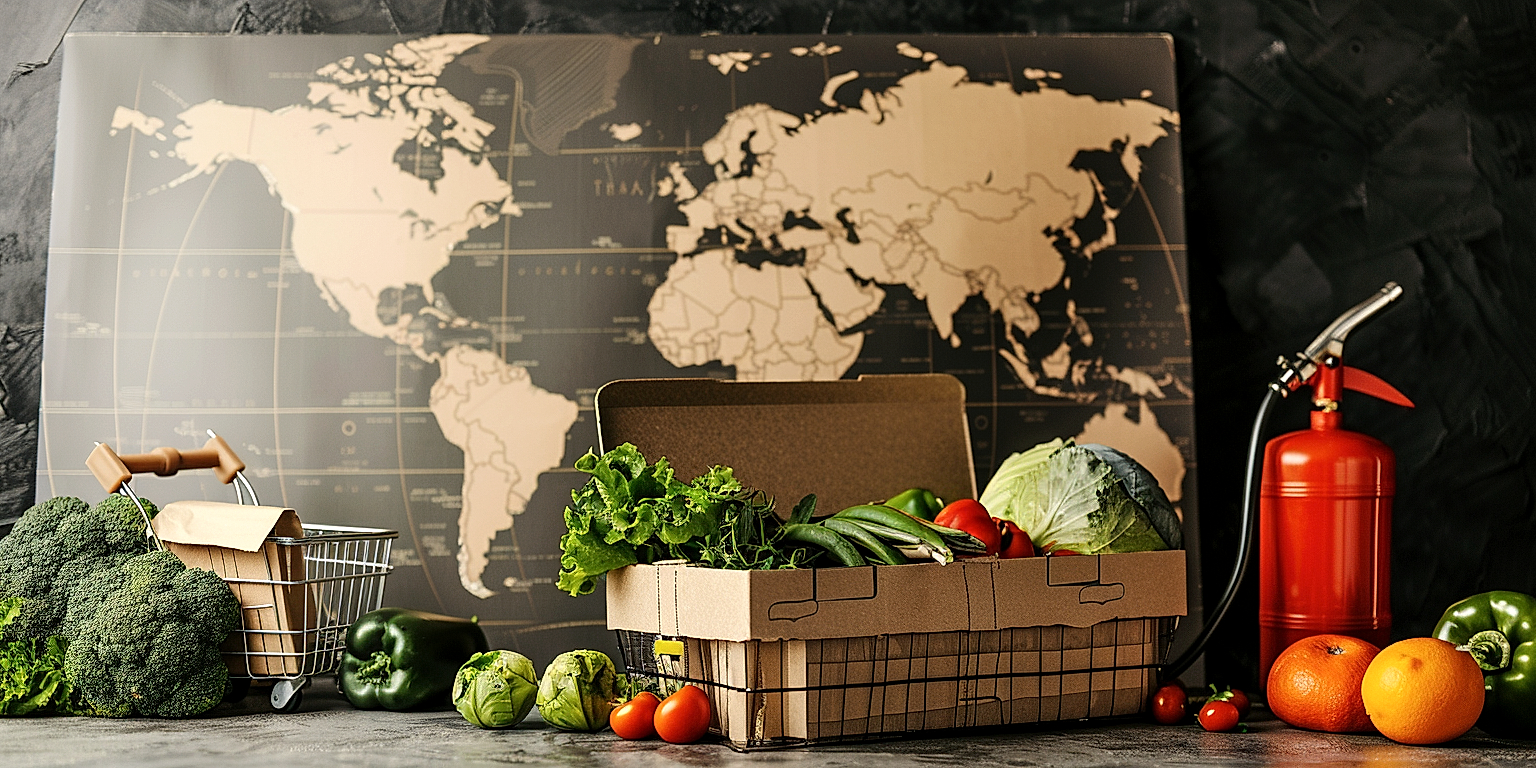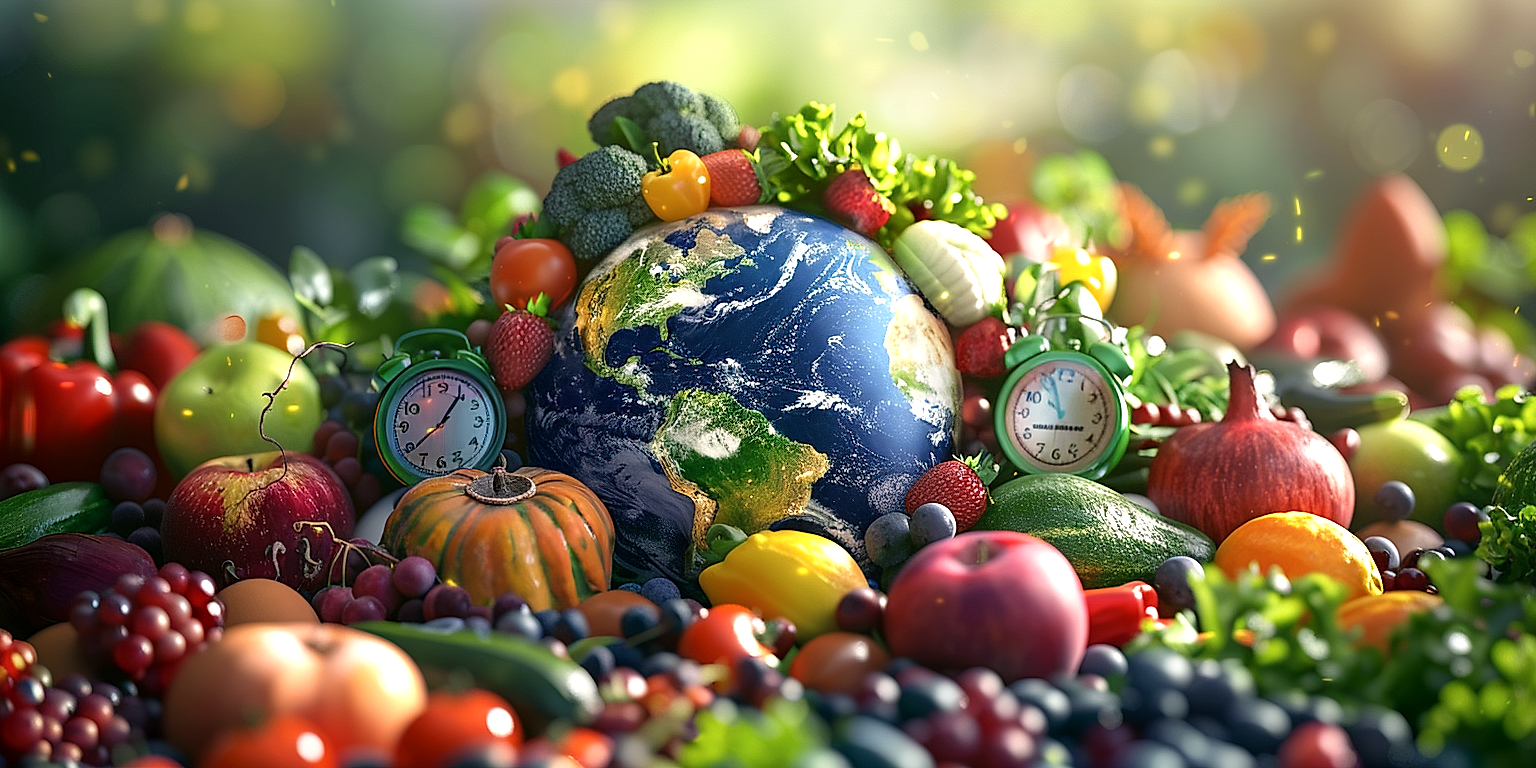In today’s globalized economy, the technology utilized in shipping and logistics has evolved drastically.
Every chain of the supply system, particularly for produce shipping, is now benefiting from major technological advancements.
From harvest to home, each step of the process is enhanced with technology, ensuring efficiency, effectiveness, and cost control.
This evolution has profoundly transformed the way produce is packed, preserved, monitored, and delivered.
Yet, it’s essential to recognize this is far from a static situation.
Continually evolving technologies promise further exciting developments in the future of produce shipping.
Technological Advancements Shaping Produce Shipping
1. Autonomous Vehicles and Drones
The revolution in the world of transportation is currently being driven by a series of technological advancements, predominantly by the advent of Autonomous Vehicles and Drones.
These technologies have exhibited immense potential in enhancing efficiency and safety, especially in the aspect of produce shipping.
The application of unmanned vehicles extends far and wide, right from the fields of agriculture to the intricate web of supply chain management.
Autonomous Vehicles, for example, can be pre-programmed to follow optimal routes for transportation, which reduces the wastage of time in decision-making during transit.
This advancement helps minimize the risk of product damage due to delays, therefore ensuring that the produce being shipped is fresh and of high quality.
Furthermore, these unmanned vehicles prove to be a viable solution for transporting goods to remote or hard to reach locations.
All of this can be achieved without the necessity for human intervention, thus reducing labor costs and human error.
With the employment of appropriate sensor technology, produce can be closely monitored during transit for temperature and humidity control, resulting in minimal spoilage.
The applicability of drones, on the other hand, is highly advantageous in terms of speed, especially for intra-city deliveries.
These flying robots, unlike traditional wheeled vehicles, are not subjected to traffic congestion and can therefore deliver fresh produce faster.
Moreover, the utilization of drones allows for real-time tracking and delivery confirmation, ensuring products reach their intended destination within the agreed time frame.
An amalgamation of these technologies would pave the way for a transportation system that is not only expedient, but also more efficient and much smarter.
There are, however, a few challenges that the industry will need to overcome.
There are concerns regarding safety, legal and regulatory factors, along with the consumer reception of such advancements.
Regardless, with constant advancements in technology and a positive shift in regulatory behaviors, the future of produce shipping and transportation lies with autonomous vehicles and drones.
Overcoming these barriers would revolutionize the way we ship and receive produce, making the entire process quicker, safer, and more efficient.
2. Advanced Packaging Technologies
Advanced packaging technologies are significantly affecting the produce shipping industry, with a shift towards more economical, sustainable, and protective solutions.
These technologies aim to reduce the environmental footprint of shipping, enhance product protection, and optimize costs.
The advancement in biodegradable and recyclable materials translates into a lesser environmental impact, aligning with rising eco-friendly consciousness amongst consumers.
Edible coating technologies help extend the shelf life of fresh produce, providing a natural barrier against humidity, oxygen, and microbes.
This enhancement implies less waste, helping ensure that products arrive in optimal conditions even after long shipping times.
Such technologies may include ingredients with antimicrobial properties, further reducing decay rates and product loss.
Developments in active packaging, which responds to changes in the product’s environment, also contribute to maintaining product quality during transportation.
This action includes regulating humidity levels within the package, absorbing ethylene gas – which accelerates fruit ripening – or releasing anti-microbial substances.
Smart packaging technologies embedded with sensors or indicators monitor product status and provide real-time information.
This approach enables greater traceability and transparency, assisting in quality control, reducing waste, and allowing immediate response to fluctuations in parameters such as temperature.
Improved packaging materials – such as insulated shipping containers – protect the produce from extreme temperature fluctuations during transportation, which is critical for sensitive products like fruits and vegetables.
Technologies like blast freezing and vacuum insulation provide resistance to external temperature changes, ensuring that produce maintains quality regardless of external conditions.
These technologies are accompanied by commercial and regulatory developments that are increasingly pushing produce shipping towards more sustainable practices.
Companies are realizing that adopting these technologies not only benefit the environment, but may also enhance their brand image, customer satisfaction, and eventually, profitability.
In summary, the popularity of advanced packaging technologies is growing in the produce shipping industry, balancing demands for operational efficiencies, product quality, cost-effectiveness, and environmental sustainability.
3. IoT Devices for Condition Monitoring
Among the various technological advancements that are reshaping produce shipping, none is perhaps quite as transformative as the use of Internet of Things (IoT) devices for condition monitoring.
IoT refers to a network of physical devices embedded with sensors and software that are interconnected and able to share data without human intervention.
In the context of produce shipping, IoT devices have found a valuable application in ensuring perfect state of preservation of the goods during transit.
Through real-time condition monitoring, IoT devices are helping to drastically reduce spoilage and waste, and thereby improve food security.
These devices can monitor a number of key factors, such as temperature, humidity, and gas composition within shipping containers.
If the condition inside the container deviates from the ideal parameters, the IoT device sends an automatic alert to the supply chain managers.
This allows for timely interventions to be made before the produce becomes unsuitable for consumption.
IoT devices can also track and trace the produce during its journey from the farm to the consumer.
This ensures greater transparency in the supply chain and increases confidence among consumers regarding the source and quality of their food.
Through the use of advanced analytics, IoT devices can contribute to the optimization of the shipping process.
This is done by analyzing the data gathered over time to identify patterns and trends that can help improve the efficiency and effectiveness of the supply chain.
IoT devices for condition monitoring offer the potential to transform produce shipping in many different ways – from improving food safety and quality controls, to enhancing transparency and efficiency in the supply chain.
However, the integration of IoT devices into the supply chain also presents certain challenges – primarily related to the implementation, interoperability, and security of these systems.
Despite these challenges, the potential benefits of IoT devices for condition monitoring make this technology a critical piece of the puzzle in shaping the future of produce shipping around the globe.
Given the increasingly global nature of food supply chains, and the growing demand for transparency and accountability, the adoption of IoT devices in produce shipping is likely to continue to grow in the years to come.
4. Blockchain for Supply Chain Transparency
The advancement of technology affects more than just producing and shipping of products; it has significantly changed the way we track the transportation process as well.
One innovative technology that has come to the forefront in recent years is the use of blockchain technology for supply chain transparency.
Blockchain is a decentralized, public ledger where transactions are recorded and confirmed anonymously.
It allows for complete transparency in every step of the product lifecycle, from cultivation to the end consumer.
This is particularly important in the produce shipping industry because: it not only helps to ensure quality control and product safety protocols are maintained, but it also dramatically increases efficiency and accountability.
With the implementation of blockchain technology in the supply chain, each transaction, transfer or movement of goods can be monitored, recorded and verified – fostering complete transparency in the supply chain.
By creating a permanent history of a product, blockchain technology allows for instantaneous tracing in case of any issues such as a recall.
This, in turn, has the potential to greatly reduce costs and wasted time associated with conventional tracking methods.
The blockchain solutions also offer a level of securing the authenticity of goods, mitigating the risk of counterfeit produce from entering the supply chain.
While blockchain technology is still in its early stages of adoption in supply chain management, many large companies are beginning to explore its potential benefits.
For example, Walmart has started using blockchain technology to track the journey of fresh produce from suppliers to store shelves.
The result has been increased consumer confidence in their products due to real-time access to information about the products’ origins and journey.
Despite being relatively new, blockchain technology is proving to be transformative for the transportation and produce shipping industry.
The way it fosters transparency, accountability, and efficiency within the supply chain makes it a vital tool for ensuring the safe and effective transport of fresh produce all over the world.
As technology continues to advance, the role of blockchain will likely continue to evolve and go beyond just supply chain transparency to introduce new possibilities for the global produce shipping industry itself.
5. AI-Powered Route Optimization
Artificial Intelligence (AI) is revolutionizing various aspects of our daily lives and industries, and a key area of impact in the shipping industry is route optimization.
Used in the context of produce shipping, AI-powered route optimization helps in reducing delivery times, lowering fuel consumption, and optimizing the use of available resources.
By analyzing vast amounts of logistical data from multiple sources, AI algorithms can accurately predict the fastest and most cost-effective routes for shipping goods.
This level of sophistication goes beyond just choosing the shortest path, as traditional route planning methods would do.
The smart algorithm takes into account real-time factors such as traffic conditions, weather patterns, roadworks, and local events that could potentially delay the journey.
In line with that, AI is moving away from the conventional static routing and leaning more towards dynamic routing.
Dynamic routing involves adjusting and recalculating routes in real-time, based on the individual variables at any given moment.
This continuous optimization process ensures that the chosen route remains the most effective at all times, hence reducing delays, saving costs, and improving customer satisfaction.
This technology is particularly advantageous in the context of produce shipping.
Fresh produce has a short shelf life and requires quick and efficient transportation to ensure that it arrives at its destination while still fresh.
By minimizing transport times and even foreseeing potential delays, AI-powered route optimization contributes significantly to maintaining the quality of the shipped produce.
The use of AI in route optimization is also environmentally beneficial.
Reduced fuel consumption not only lowers operational costs for shipping companies, but also contributes to a significant reduction in carbon emissions.
Aside from environmental and cost benefits, AI can enhance route safety by considering accident data and hazardous road conditions when determining the optimal paths.
In addition, AI provides insightful data that can be leveraged for future planning and decision-making, offering a competitive edge to businesses that utilize this technology.
Indeed, the incorporation of AI-powered route optimization in the shipping industry stands as an excellent example of how technological advancements are shaping and enhancing produce shipping operations.
6. Cold Chain Technologies
Cold chain technologies are revolutionizing the shipping industry, particularly in the area of produce transportation.
The advancements in cold chain technologies are ensuring that produce stays fresh from the moment it’s picked until it reaches the consumer.
These technologies are responsible for maintaining a consistent temperature during transit, preventing spoilage and ensuring the delivery of safe and quality produce.
A critical advancement in cold chain technology is real-time temperature monitoring.
This feature allows shippers to measure and track temperatures accurately, ensuring that the produce does not suffer from fluctuations that could potentially harm its quality.
Another significant cold chain advancement is the development of true cold chain visibility.
This enhanced visibility enables shippers to track and trace their perishable goods from the field to the store, increasing overall control over the produce.
Besides, novel packaging solutions are also a part of cold chain advancements.
These include insulated packaging and phase-changing materials that can maintain the cold temperature for extended periods.
All these technologies work together to make cold transportation of produce more efficient, thereby reducing food waste and increasing profits.
Moreover, cold chain technologies are also supporting sustainability efforts in the supply chain industry.
By improving the efficiency of refrigeration equipment and reducing energy consumption, they are helping to minimize the environmental footprint of the shipping industry.
Furthermore, the integration of IoT devices and sensors within these technologies is enhancing data collection, tracking, and control over cold chain proceedings.
The predictive capabilities of these technologies are providing real-time insights into possible disruptions, failures, or inefficiencies.
This technological enhancement is allowing for more proactive decision-making and prevention of potential cold chain disruptions.
To sum it up, the improvements and advancements in cold chain technologies play an instrumental role in shaping the future of produce shipping.
7. Machine Learning for Demand Forecasting
Any efficient supply chain management is heavily reliant on accurate demand forecasting.
This insightful foresight enables businesses to plan adequately for the future, channeling resources appropriately to meet customer needs.
The traditional methods of demand forecasting, such as historical sales data analysis, while effective, are increasingly becoming outdated in the face of modern technology.
There is a pressing need for more accurate, real-time, and data-driven demand forecasting methodologies.
Enter machine learning – a subset of artificial intelligence that is gradually becoming a game-changer in many sectors, including supply chain management and logistics.
In the context of produce shipping, machine learning algorithms can be trained to ensure more accurate demand forecasting.
The power of machine learning lies in its ability to analyze vast data sets, draw patterns, learn from them and make accurate predictions. This catalyzes process automation and efficient decision-making in the supply chain.
The algorithms can analyze historical data, current market trends, seasonality factors, among other data sets, to predict future demand trends accurately.
One of the key benefits of using machine learning for demand forecasting is the ability to dynamically adjust to changing market conditions.
While traditional methods may fail to capture sudden market shifts or unprecedented events (such as a global pandemic), machine learning models can assimilate new data, learn from it, and adjust their predictions accordingly.
In the produce shipping industry, this equates to reduced wastage due to overproduction, improved customer satisfaction levels due to timely product availability and ultimately, increased profitability.
The power of machine learning in demand forecasting also extends to predictive analytics for pricing.
Factors such as competition dynamics, demand-supply balances and changing consumer preferences can be captured and analyzed by machine learning models to optimize pricing strategies.
This helps businesses within the produce shipping sector to maintain competitive edge, ensure profitability and enhance customer satisfaction.
Moreover, machine learning models for demand forecasting can be integrated with other emerging technologies such as IoT devices for condition monitoring, blockchain for supply chain transparency and AI-powered route optimization, to deliver more efficient and smart produce shipping solutions.
Therefore, it is evident that machine learning has a transformative role in produce shipping, and specifically in demand forecasting, making it one of the key technological advancements shaping the industry.
The Bottom Line
Driving a revolution within the logistics and supply chain management sector are transformative technologies such as autonomous vehicles and drones, advanced packaging concepts, and IoT devices for real-time condition monitoring.
By offering unprecedented transparency and traceability, blockchain offers a paradigm shift for managing intricate supply chains.
Moreover, AI-powered route optimization promises to drive efficiency and reduce carbon footprints, while cold chain technologies provide a lifeline for industries that require strict temperature controls.
Bringing it all together, machine learning is setting a precedent in accurate demand forecasting, making inventory mismanagement a thing of the past.
Embracing these emerging technologies will be essential for logistics and supply chain businesses to not only remain competitive but also to thrive in the digital era.




